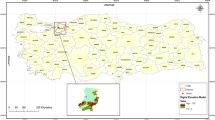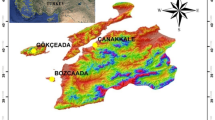Abstract
The present study aimed to model reconnaissance drought index (RDI) time series at three various time scales (i.e., RDI-6, RDI-9, RDI-12). Two weather stations located at Iran, namely Tehran and Dezful, were selected as the case study. First, support vector regression (SVR) was utilized as the standalone modeling technique. Then, hybrid models were implemented via coupling the standalone SVR with two bio-inspired-based techniques including firefly algorithm (FA) and whale optimization algorithm (WOA) as well as wavelet analysis (W). Accordingly, the hybrid SVR-FA, SVR-WOA, and W-SVR models were proposed. It is worth mentioning that six mother wavelets (i.e., Haar, Daubechies (db2, db4), Coifflet, Symlet, and Fejer-Korovkin) were employed in development of the hybrid W-SVR models. The performance of models was assessed through root mean square error (RMSE), mean absolute error (MAE), Willmott index (WI), and Nash-Sutcliffe efficiency (NSE). Generally, the implemented coupled models illustrated better results than the standalone SVR in modeling the RDI time series of studied locations. Besides, the Coifflet mother wavelet was found to be the best-performing wavelet. The most accurate results were achieved for RDI-12 modeling via the W-SVR utilizing db4(2) at Tehran station (RMSE = 0.253, MAE = 0.174, WI= 0.888, NSE = 0.934) and Coifflet(2) at Dezful station (RMSE = 0.301, MAE = 0.166, WI= 0.910, NSE = 0.936). As a result, the hybrid models developed in the current study, specifically W-SVR ones, can be proposed as suitable alternatives to the single SVR.







Similar content being viewed by others
References
Adarsh S, Reddy MJ (2019) Evaluation of trends and predictability of short-term droughts in three meteorological subdivisions of India using multivariate EMD-based hybrid modelling. Hydrol Process 33(1):130–143
Ahmadi F, Mehdizadeh S, Mohammadi B, Pham QB, DOAN TNC, Vo ND (2020) Application of an artificial intelligence technique enhanced with intelligent water drops for monthly reference evapotranspiration estimation. Agric Water Manag 244:106622
Al-Quraishi AMF, Qader SH, Wu W (2020) Drought monitoring using spectral and meteorological based indices combination: a case study in Sulaimaniyah, Kurdistan region of Iraq. In Environmental Remote Sensing and GIS in Iraq (pp. 377–393). Springer, Cham
Athira K (2019) Assessment of Meteorological Drought in Anantapur District (Andhra Pradesh). J Water Resour Res Dev 2(1, 2)
Boggess A, Narcowich FJ, Donoho DL, Donoho PL (2002) Wavelets with Fourier analysis. Phys Today 55(5):63
Das P, Naganna SR, Deka PC, Pushparaj J (2020) Hybrid wavelet packet machine learning approaches for drought modeling. Environ Earth Sci 79:221
de Martonne E (1925) Traité de Géographie Physique, 3 tomes Paris
Dehghan S, Salehnia N, Sayari N, Bakhtiari B (2020) Prediction of meteorological drought in arid and semi-arid regions using PDSI and SDSM: a case study in Fars Province, Iran. J Arid Land 12:318–330
Deo RC, Sahin M (2015) Application of the extreme learning machine algorithm for the prediction of monthly Effective Drought Index in eastern Australia. Atmos Res 153:512–525
Deo RC, Salcedo-Sanz S, Carro-Calvo L, Saavedra-Moreno B (2018) Chapter 10 - Drought prediction with standardized precipitation and evapotranspiration index and support vector regression models. Integ Disaster Sci Manag Global Case Stud Mitigation Recov 151–174
Edwards DC (1997) Characteristics of 20th Century drought in the United States at multiple time scales. Climatology Report Number 97–2, Department of Atmospheric Science, Colorado State University, Fort Collins 174
Feng P, Wang B, Liu DL, Yu Q (2019) Machine learning-based integration of remotely-sensed drought factors can improve the estimation of agricultural drought in South-Eastern Australia. Agric Syst 173:303–316
Freire PKDMM, Santos CAG, da Silva GBL (2019) Analysis of the use of discrete wavelet transforms coupled with ANN for short-term streamflow forecasting. Appl Soft Comput 80:494–505
Graf R, Zhu S, Sivakumar B (2019) Forecasting river water temperature time series using a wavelet–neural network hybrid modelling approach. J Hydrol 578:124115
Guttman NB, Wallis JR, Hosking JRM (1992) Spatial Comparability of the Palmer Drought Severity Index. JAWRA J Am Water Resour Assoc 28(6):1111–1119
Hadian F, Jafari R, Bashari H, Tarkesh M, Clarke KD (2019) Effects of drought on plant parameters of different rangeland types in Khansar region, Iran. Arab J Geosci 12(3):93
Kaur A, Sood SK (2020) Deep learning based drought assessment and prediction framework. Ecol Inform 57:101067
Khan N, Sachindra DA, Shahid S, Ahmed K, Shiru MS, Nawaz N (2020a) Prediction of droughts over Pakistan using machine learning algorithms. Adv Water Resour 139:103562
Khan MMH, Muhammad NS, El-Shafie A (2020b) Wavelet based hybrid ANN-ARIMA models for meteorological drought forecasting. J Hydrol 590:125380
Maheswaran R, Khosa R (2012) Comparative study of different wavelets for hydrologic forecasting. Comput Geosci 46:284–295
Malik A, Kumar A, Singh RP (2019) Application of heuristic approaches for prediction of hydrological drought using multi-scalar streamflow drought index. Water Resour Manag 33:3985–4006
McKee TB, Doesken NJ, Kleist J (1993) The relationship of drought frequency and duration to time scales. In Proceedings of the 8th Conference on Applied Climatology (Vol. 17, No. 22, pp. 179-183).
Mehdizadeh S (2018) Assessing the potential of data-driven models for estimation of long-term monthly temperatures. Comput Electron Agric 144:114–125
Mehdizadeh S, Behmanesh J, Khalili K (2018) Comprehensive modeling of monthly mean soil temperature using multivariate adaptive regression splines and support vector machine. Theor Appl Climatol 133(3):911–924
Mehdizadeh S, Ahmadi F, Mehr AD, Safari MJS (2020) Drought modeling using classic time series and hybrid wavelet-gene expression programming models. J Hydrol 587:125017
Mirjalili S, Lewis A (2016) The whale optimization algorithm. Adv Eng Softw 95:51–67
Mishra AK, Singh VP (2010) A review of drought concepts. J Hydrol 391(1–2):202–216
Moazenzadeh R, Mohammadi B (2019) Assessment of bio-inspired metaheuristic optimisation algorithms for estimating soil temperature. Geoderma 353:152–171
Mohammadi B, Mehdizadeh S (2020) Modeling daily reference evapotranspiration via a novel approach based on support vector regression coupled with whale optimization algorithm. Agric Water Manag 237:106145
Rahmati O, Panahi M, Kalantari Z, Soltani E, Falah F, Dayal KS, Mohammadi F, Deo RC, Tiefenbacher J, Bui DT (2020) Capability and robustness of novel hybridized models used for drought hazard modeling in southeast Queensland, Australia. Sci Total Environ 718:134656
Rezaeian-Zadeh M, Tabari H (2012) MLP-based drought forecasting in different climatic regions. Theor Appl Climatol 109:407–414
Roodposhti MS, Safarrad T, Shahabi H (2017) Drought sensitivity mapping using two one-class support vector machine algorithms. Atmos Res 193:73–82
Sang YF (2013) A review on the applications of wavelet transform in hydrology time series analysis. Atmos Res 122:8–15
Seo Y, Kim S, Kisi O, Singh VP (2015) Daily water level forecasting using wavelet decomposition and artificial intelligence techniques. J Hydrol 520:224–243
Shen R, Huang A, Li B, Guo J (2019) Construction of a drought monitoring model using deep learning based on multi-source remote sensing data. Int J Appl Earth Observ Geoinform 79:48–57
Shoaib M, Shamseldin AY, Khan S, Sultan M, Ahmad F, Sultan T, Dahri ZH, Ali I (2019) Input selection of wavelet-coupled neural network models for rainfall-runoff modeling. Water Resour Manag 33:955–973
Shoaib M, Shamseldin AY, Melville BW, Khan MM (2016) A comparison between wavelet based static and dynamic neural network approaches for runoff prediction. J Hydrol 535:211–225
Sun Y, Niu J, Sivakumar B (2019) A comparative study of models for short-term streamflow forecasting with emphasis on wavelet-based approach. Stoc Environ Res Risk Assess 33(10):1875–1891
Surendran U, Anagha B, Raja P, Kumar V, Rajan K, Jayakumar M (2019) Analysis of drought from humid, semi-arid and arid regions of India using DrinC model with different drought indices. Water Resour Manag 33(4):1521–1540
Tigkas D (2008) Drought characterisation and monitoring in regions of Greece. Europ Water 23(24):29–39
Tsakiris G, Pangalou D, Vangelis H (2007) Regional drought assessment based on the Reconnaissance Drought Index (RDI). Water Resour Manag 21(5):821–833
Tsakiris G, Vangelis H (2005) Establishing a drought index incorporating evapotranspiration. Eur Water 9(10):3–11
Tufaner F, Özbeyaz A (2020) Estimation and easy calculation of the Palmer Drought Severity Index from the meteorological data by using the advanced machine learning algorithms. Environ Monit Assess 192:576
Vangelis H, Tikgas D, Tsakiris G (2013) The effect of PET method on Reconnaissance Drought Index (RDI) calculation. J Arid Environ 88:130–140
Vapnik V, Chervonenkis A (1974) Theory of pattern recognition. Nauka, Moscow
Vidyarthi VK, Jain A (2020) Knowledge extraction from trained ANN drought classification model. J Hydrol 585:124804
Wang W, Ding J (2003) Wavelet network model and its application to the prediction of hydrology. Nature Sci 1(1):67–71
Yang XS (2009) Firefly algorithms for multimodal optimization. Int Symp Stoch Algo 5792:169–178
Zarei AR, Mahmoudi MR (2020) Ability assessment of the stationary and cyclostationary time series models to predict drought indices. Water Resour Manag 34(15):5009–5029
Funding
This paper has not received any funding.
Author information
Authors and Affiliations
Contributions
Farshad Ahmadi: Methodology, Software, Writing – Review & Editing; Saeid Mehdizadeh: Conceptualization, Methodology, Writing – Review & Editing; Babak Mohammadi: Methodology, Software, Writing – Review & Editing
Corresponding author
Ethics declarations
Ethics Approval
Not applicable.
Consent to Participate
Not applicable.
Consent to Publish
Not applicable.
Competing Interests
There is not any competing interest.
Additional information
Publisher's Note
Springer Nature remains neutral with regard to jurisdictional claims in published maps and institutional affiliations.
Rights and permissions
About this article
Cite this article
Ahmadi, F., Mehdizadeh, S. & Mohammadi, B. Development of Bio-Inspired- and Wavelet-Based Hybrid Models for Reconnaissance Drought Index Modeling. Water Resour Manage 35, 4127–4147 (2021). https://doi.org/10.1007/s11269-021-02934-z
Received:
Accepted:
Published:
Issue Date:
DOI: https://doi.org/10.1007/s11269-021-02934-z




